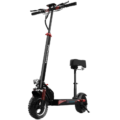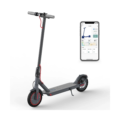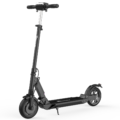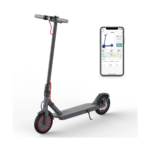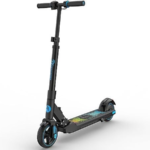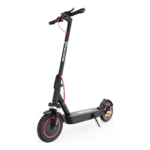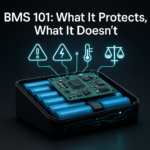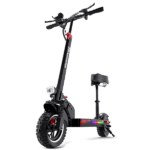- Home
- Scooters
- Electric Scooters
- EVERCROSS EV10Z
EVERCROSS EV10Z


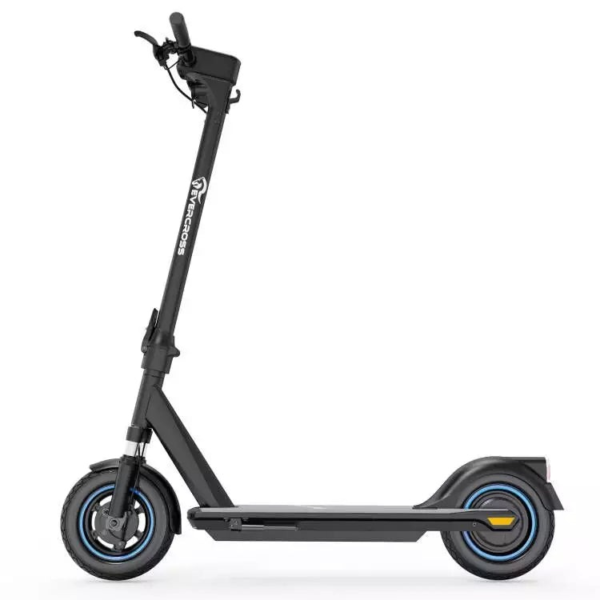
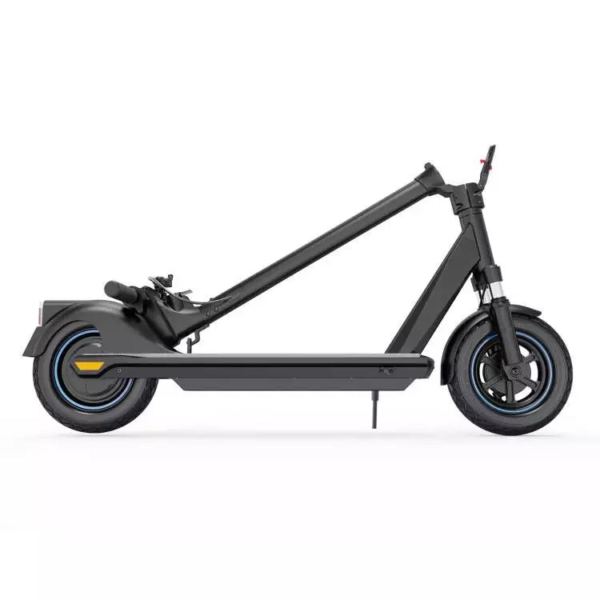
- Battery Range: 22–25 miles (35–40 km)
- Top Speed: 12.4 mph (20 km/h)
- Motor Power: 350 W
- Weight Capacity: 220 lb (100 kg)
- Charging Time: ~6 h
- Scooter Weight: 35.5 lb (16.1 kg)
PROS
- 10″ solid tires (no flats)
- Front drum + rear electronic brake
- Front spring + twin rear shocks
- Bluetooth app with basic controls
- Compact fold (44.5×18.9×23.2 in)
- Street-legal ABE variant available
CONS
- EU ABE speed limited to 20 km/h
- IP rating not published
- Solid tires ride firmer
- Some listings vary on battery spec (10.4–11.4 Ah)

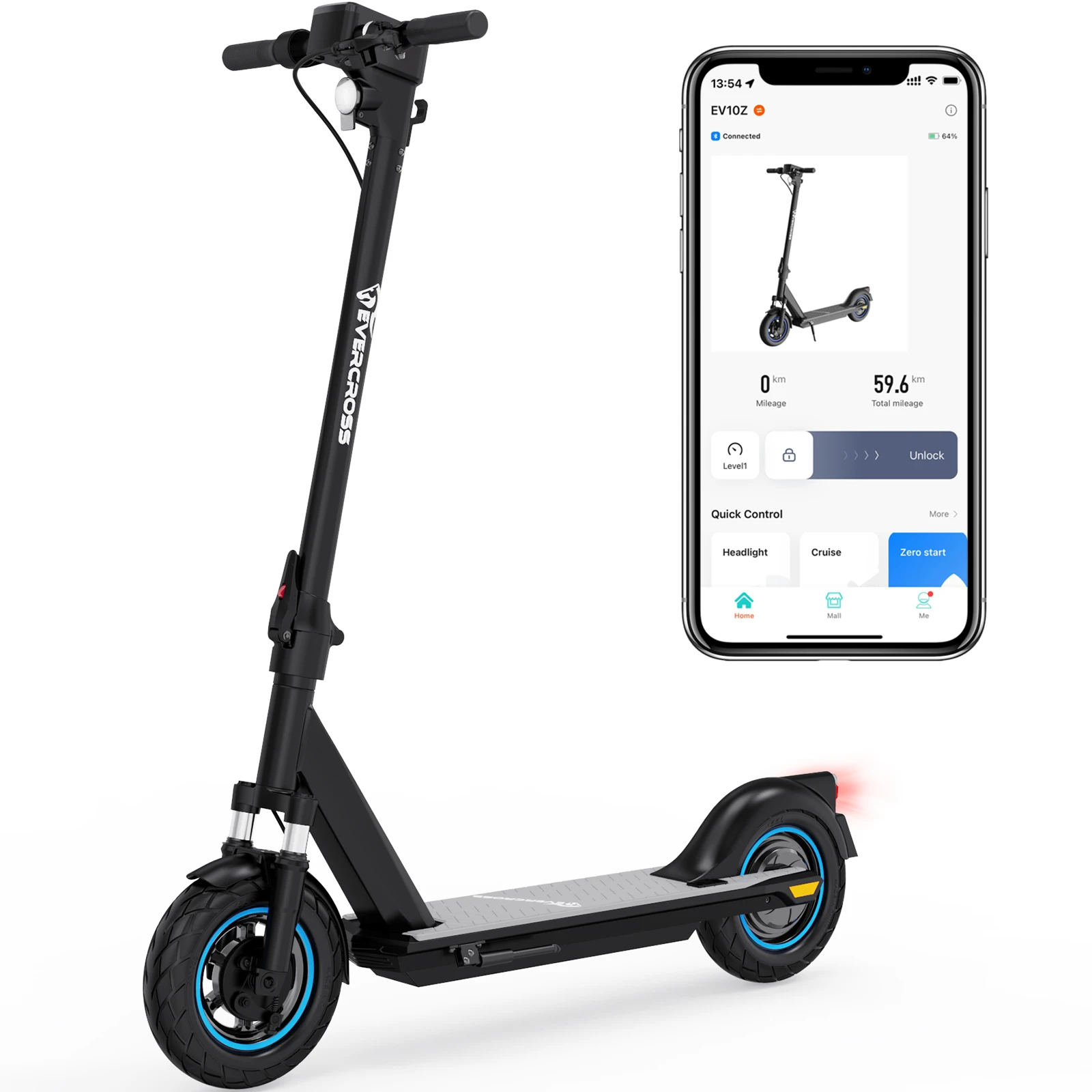

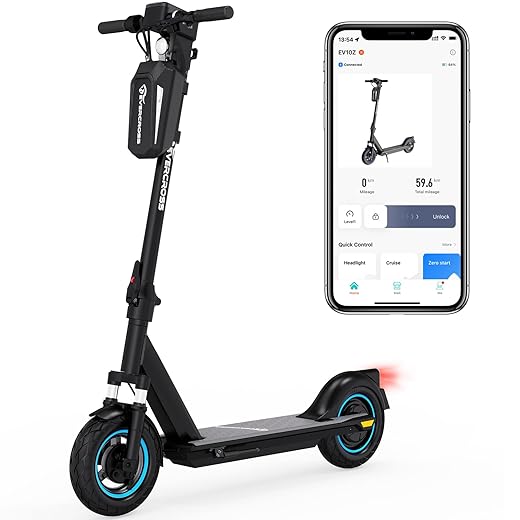
Table of contents
- What Is the EVERCROSS EV10Z?
- How the EVERCROSS EV10Z Works
- Key Specifications
- Design & Build Quality
- Performance Fundamentals
- Battery, Range & Efficiency
- Ride Quality & Comfort
- Braking & Safety Features
- Portability & Daily Usability
- Maintenance & Care
- Weather & Seasonal Considerations
- EVERCROSS EV10Z vs Alternatives
- Who the EVERCROSS EV10Z Is (and Isn’t) For
- FAQs
- Glossary
- Final Thoughts
The EVERCROSS EV10Z is a compact, app-enabled commuter scooter designed for everyday rides across town and campus. It blends a 500W peak brushless hub motor, a 36V battery, 10-inch solid tires, and a practical folding design that fits under a desk or in a car trunk. As a result, it suits riders who want low maintenance, simple controls, and predictable handling for gentle hills and daily errands. If you’re also considering a step-up within the same brand, the EVERCROSS EV10K Pro offers more headroom for power and pace while keeping commuter practicality.
What Is the EVERCROSS EV10Z?
The EVERCROSS EV10Z is a lightweight, foldable electric scooter built for short-to-medium urban trips. It prioritizes reliable hardware over flash, pairing a 36V 11.4Ah battery with a hub motor tuned for smooth starts and steady cruising. Moreover, the 10-inch honeycomb (solid) tires remove flat worries, while a front shock and rear shock setup (on many units) adds compliance over patched asphalt and expansion joints. In addition, a mechanical front brake working with electronic regen provides balanced stops, and the LED headlight, taillight, and side reflectors improve visibility at dusk.
Regionally, you’ll find distinct speed profiles. In many markets the EV10Z ships with a 15.5 mph (25 km/h) cap to align with local rules, while other regions allow an unlocked top speed up to about 19 mph (30 km/h). Furthermore, a German ABE-compliant variant is limited to 12.5 mph (20 km/h). Even so, the riding character stays consistent: calm, easy to manage, and confidence-building for new and returning riders.
How the EVERCROSS EV10Z Works
Think of the EVERCROSS EV10Z as a compact system with five parts that coordinate seamlessly:
Motor. A brushless hub motor sits in the rear wheel. Because it’s brushless, there are no brushes to wear out, which keeps maintenance low. Additionally, power comes on progressively, so starts feel predictable rather than jumpy.
Controller. The controller is the scooter’s “brain.” It interprets your throttle input and meters battery power to the motor. It also governs speed modes (Eco/Drive/Sport), manages electronic braking, and enforces speed limits based on regional settings. Consequently, the scooter feels consistent from ride to ride.
Battery. A 36V lithium-ion pack rated at 11.4Ah (about 410 Wh) lives under the deck. That capacity supports typical city rides of a few miles each and, with moderate pacing, a full day of short trips before recharging. Meanwhile, a 42V charger at ~2A brings the pack back in roughly six hours.
Throttle. A thumb throttle tells the controller how fast you want to go. Because the controller smooths your requests, you don’t get a sudden surge; instead, the scooter eases into speed. Also, the app lets you switch units (mph/km/h), set modes, and toggle cruise control for steady paths.
Brakes. The front wheel uses a mechanical brake (disc on many units; drum on some regional versions). The rear adds electronic regenerative braking (E-ABS). When you squeeze the lever, you’ll feel firm initial bite from the front brake, then a mild “drag” from regen that slows the rear wheel and recovers a bit of energy. Therefore, stops feel progressive rather than abrupt.
Key Specifications
Below are the official, core specifications for the EV10Z, presented US-first with metric equivalents. (Regional variants may differ slightly to meet local rules.)
| Category | Item | Detail |
|---|---|---|
| General | Model | EVERCROSS EV10Z |
| Intended use | Urban commuting, campus, errands | |
| App | Bluetooth app for modes, units, lock, cruise control | |
| Performance & Power | Motor | 500W peak brushless rear hub (some ABE variants rated 350W) |
| Top speed (limited) | 15.5 mph (25 km/h) typical limit; up to ~19 mph (30 km/h) where permitted | |
| Hill grade | Advertised up to 15°; expect steady climbs on ~7–10% grades | |
| Battery, Charging & Electrical | Battery | 36V 11.4Ah (≈410 Wh) lithium-ion |
| Charger | 42V, ~2A; ~6 hours to full | |
| Riding modes | Eco / Drive / Sport; cruise control available | |
| Build & Dimensions | Tires | 10 in honeycomb (solid) rubber |
| Suspension | Front spring shock; dual rear shocks on many units | |
| Weight | 35.5 lb (16.1 kg) | |
| Max load | 220 lb (100 kg) | |
| Unfolded (L×W×H) | 44.5 × 18.9 × 48.8 in (1130 × 480 × 1240 mm) | |
| Folded (L×W×H) | 44.5 × 18.9 × 23.2 in (1130 × 480 × 590 mm) | |
| Safety & Control | Brakes | Front mechanical (disc or drum, region-dependent) + rear electronic regen (E-ABS) |
| Lighting | LED headlight, taillight/brake light, reflectors | |
| Kickstand | Side-mount | |
| Features & Extras | Display | Handlebar display with speed, battery bars, mode, errors |
| Cruise Control | Yes (toggle via display/app) | |
| Start mode | Zero-start / non-zero start selectable | |
| Warranty & Compliance | Warranty | Typically 12–18 months (varies by region/vendor) |
| Compliance | CE (EU); ABE variant available (20 km/h); local laws vary |
(This specifications table reflects the core hardware common to EV10Z variants.)
Design & Build Quality
The EV10Z follows a proven commuter layout: a one-piece deck with the battery sealed underneath, a folding stem with a secondary safety latch, and a tidy cockpit that keeps critical controls within thumb reach. The deck is flat and grippy, with enough length to ride staggered—front foot slightly angled, rear foot across the deck edge—for better balance on bumps. Additionally, the stem’s cross-section resists twisting under normal braking, and although you can provoke a faint shimmy at higher speed with a loose grip, the scooter stays composed when you keep light, steady pressure through both hands.
Fit-and-finish is better than the class average. Harnessing is routed cleanly and doesn’t snag when you fold the stem. Moreover, the fold itself takes seconds: flip the latch, lower the stem to the rear hook, and you’ve got a compact 44.5-inch (1130 mm) package that slides into car trunks or under tables. The honeycomb tires and sealed electrical connectors simplify life in two ways: no tubes to puncture and fewer exposed bits to fuss over after a damp commute. Finally, you’ll notice small touches—an easy-to-reach charge port cap, a stable kickstand, and tactile buttons on the display—that make daily use less fussy.
Performance Fundamentals
Acceleration. In Eco mode, the EV10Z eases off the line with a gentle ramp that’s beginner-friendly. Drive mode adds snap for stoplights, while Sport delivers the strongest push without feeling twitchy. From a dead stop, the scooter moves best with a small kick, then a steady press on the throttle. That technique lets the controller settle in and keeps the front end planted. As a result, starts feel smooth rather than abrupt.
Cruising stability. At neighborhood speeds, the wheelbase and tire profile give the EV10Z a neutral, no-drama feel. The steering is light but not nervous, and the stem stays notably free of flex under normal loads. On smooth stretches, you can lift your gaze, relax your shoulders, and let the scooter track straight with minimal input. Furthermore, crosswinds bother it less than ultra-light models, thanks to the balanced deck weight.
Hills. Advertised claims often cite “up to 15°,” but real urban grades are better expressed in percent. On ~7–10% hills, a 170–185 lb (77–84 kg) rider will feel the EV10Z slow but continue climbing in Drive or Sport mode. Short, steeper ramps are doable with a rolling start. However, for long, very steep climbs, expect speed to taper; that’s normal for a compact 36V system focused on range and reliability.
Battery, Range & Efficiency
The 36V 11.4Ah pack holds roughly 410 Wh. In practical terms, that means:
- Short trips: A week of daily 1–2 mile (1.6–3.2 km) hops without charging.
- Moderate commutes: One 5–7 mile (8–11 km) ride each way, charging at home with capacity in reserve.
- Conservative pacing: Eco or Drive mode, smooth throttle, and 10–14 mph (16–22 km/h) cruising stretch range noticeably.
Real-world range depends on rider weight, average speed, temperature, headwinds, elevation, and how often you stop and go. A 150 lb (68 kg) rider cruising steadily on flat bike paths will see longer distances than a 210 lb (95 kg) rider tackling hills and riding at full speed. In cold weather, capacity dips—lithium batteries simply deliver less in the cold—so plan conservatively in winter.
Charging best practices. Top up after rides if you’ll need full range tomorrow. If you’re storing the EV10Z for a week or more, leave the battery around 50–70% and keep it in a cool, dry place. Avoid fully draining the pack on purpose; it doesn’t “train” lithium batteries. Also, keep the charge port dry, and always plug the charger into the scooter before connecting to the wall. Consequently, you protect the charger and reduce arcing at the connector.
Ride Quality & Comfort
Solid 10-inch honeycomb tires make punctures a non-issue and keep the rolling diameter large enough to roll over cracks that would jar smaller wheels. They ride firmer than pneumatic tires, but the front shock—and dual rear shocks on many units—takes the edge off most city chatter. You’ll still feel sharp potholes, so choose lines that avoid square-edged hits and maintain a soft knee bend to let your legs act as extra suspension. In turn, the scooter stays composed on rougher blocks.
The bar height suits riders in the 5’4″–6’2″ (163–188 cm) range. Grip diameter is comfortable, and the thumb throttle has a smooth throw that reduces hand fatigue on longer runs. Moreover, stem flex remains minimal during normal braking; you might notice a hint of movement when you brake aggressively while turning, which is a cue to straighten the scooter before hard stops. Overall, the EV10Z feels planted and predictable, which matters more than raw speed on daily rides.
Braking & Safety Features
The braking system blends a mechanical front brake with electronic rear regen. It’s tuned to feel natural: initial bite arrives from the front, then the regen adds drag to balance the scooter as you slow. Braking remains straight and steady when your weight is centered; if you stop hard, shift hips slightly rearward to keep the rear tire planted. With practice, you’ll learn the “half-lever” squeeze that gives firm deceleration without locking the front. As a result, emergency stops feel controlled rather than skittish.
Lighting is practical. The LED headlight is mounted high on the stem to cast a wide, usable beam. The taillight brightens under braking, and side reflectors improve cross-traffic visibility at intersections. Additionally, the EV10Z’s weather protection is designed for splash resistance, not immersion; avoid heavy downpours and standing water deeper than the tire’s sidewall. As always, follow local regulations on where and how to ride.
Portability & Daily Usability
At 35.5 lb (16.1 kg), the EV10Z is easy to lift for a short stair flight or onto public transit. The fold-and-latch system is quick and secure, and the compact folded height—about 23.2 in (590 mm)—makes it practical in tight apartments and office corners. Furthermore, the deck’s flat underside sits neatly against a wall or in a trunk without odd protrusions.
The app adds useful quality-of-life options: switching to mph or km/h, selecting Eco/Drive/Sport, enabling cruise control on long, flat stretches, and locking the scooter (which deters casual tampering but doesn’t replace a physical lock). Day to day, the EV10Z is the kind of scooter you can grab and go without calculations—turn it on, pick a mode, and ride. Therefore, it encourages regular use rather than occasional weekend outings.
Maintenance & Care
Solid tires already remove the most common maintenance task—tube changes. That said, a simple routine keeps the EV10Z feeling new:
- Weekly (or every 30–40 miles / 50–65 km): Wipe the deck and stem, check the folding latch tension, and inspect the brake lever feel. Also, make sure the charge port cap is seated.
- Monthly: Check all fasteners on the stem clamp, handlebar, and brake hardware. Moreover, verify the front brake’s engagement point and adjust the cable if the lever travel grows.
- Quarterly: Inspect the honeycomb tires for embedded debris and the shock pivots for play. Clean and lightly lube exposed pivot points—avoid the brake rotor/pads if your unit uses a disc.
- Battery habits: Store around 50–70% if unused for more than a week. Keep away from extreme heat and direct sun. Consequently, you preserve long-term capacity.
Firmware and app settings are straightforward; use them to set your preferred start mode (zero or non-zero), toggle cruise control, and choose speed units. If you ever see an error code, power-cycle the scooter, check connectors, and reference the on-screen code label before riding again. In many cases, a reset clears transient faults.
Weather & Seasonal Considerations
Rain. Light, passing showers are manageable if you ride slowly, avoid puddles, and dry the scooter afterward. However, solid tires plus wet paint or metal plates reduce grip. Brake earlier, stay upright through corners, and keep speeds conservative. Finally, avoid heavy rain and standing water.
Heat. High temperatures raise tire and battery temps. Park in shade, let the scooter cool before charging, and avoid leaving it sealed in a hot car. You may also notice throttling if the controller protects itself on scorching days; that’s normal. Therefore, plan gentler pacing during heat waves.
Cold. Lithium batteries deliver less energy in cold weather. Expect a noticeable range dip below ~41°F (5°C). Pre-warm the scooter indoors, ride in Eco/Drive, and plan shorter routes. When you finish, bring the scooter inside and wait until it reaches room temperature before charging. Consequently, you reduce stress on the cells.
EVERCROSS EV10Z vs Alternatives
When does the EV10Z shine? It excels as a daily commuter for short-to-medium city rouWhen does the EV10Z shine? It excels as a daily commuter for short-to-medium city routes, a campus runabout, and a last-mile connector for train or bus riders. Compared with basic 250–300W scooters, it offers stronger hill performance and steadier cruising. Against heavier, high-power scooters, it wins on weight, simplicity, and cost of ownership. On the other hand, off-road-oriented models with knobby tires and dual motors outgun it on trails, yet they’re overkill for bike paths and crowded streets. For a lighter-budget option with modest performance, the Xiaomi Electric Scooter 4 Go favors low weight and simplicity over speed, which suits flat, short routes.
If you’re choosing among classes:
- Light commuter class (under ~30 lb / 13.6 kg): Even more portable, but with smaller batteries and softer hill performance.
- Mid commuter class (~35–45 lb / 16–20 kg): The EV10Z sits here—balanced power, practical range, and manageable weight.
- Performance class (50 lb / 23 kg and up): Much faster, much heavier, and more demanding to store and carry.
Ultimately, pick the class that matches your storage space, daily elevation, and how often you’ll carry the scooter. In short, let your route and routine decide.
Who the EVERCROSS EV10Z Is (and Isn’t) For
Great for:
- New riders who want stable handling, predictable acceleration, and simple controls.
- Students commuting across campus or to nearby neighborhoods.
- Multi-modal travelers who need easy folding and reasonable weight for transit hops.
- Urban commuters with mixed terrain and a few rolling hills, not mountain climbs.
- Riders who hate flats, thanks to 10-inch solid tires.
Not ideal for:
- Very long commutes without a charging opportunity.
- Frequent off-road use on rough trails; the geometry and tires are built for pavement.
- Riders seeking 25+ mph (40+ km/h) cruising; this scooter is tuned for city-legal speeds.
Therefore, if your daily ride is practical and paved, the EV10Z’s balance of weight, range, and simplicity fits well.
FAQs
1) How fast does the EVERCROSS EV10Z go?
Most regions limit the EV10Z to 15.5 mph (25 km/h). Where rules allow, unlocked top speed is about 19 mph (30 km/h).
2) What real-world range should I expect?
Plan for roughly 12–20 miles (19–32 km) depending on weight, terrain, temperature, and average speed. Smooth riding in Eco/Drive mode extends range further.
3) Does the EV10Z have cruise control?
Yes. You can enable or disable cruise control from the display or app and use it on steady, flat paths to reduce hand fatigue.
4) What’s included in the EVERCROSS EV10Z overview?
This overview covers design, performance, battery and range, comfort, braking and safety, maintenance, weather tips, and a detailed specs table.
5) Can I ride it in the rain?
It’s splash-resistant for light showers, but avoid heavy rain, deep puddles, and pressure washing. Afterward, dry the scooter to protect components.
6) What is the maximum rider weight?
The typical rating is 220 lb (100 kg). Some regional listings may vary; follow the label on your specific unit.
7) What kind of brakes does it use?
A mechanical front brake (disc on many units; some markets use a drum) plus rear electronic regenerative braking for balanced, controlled stops.
Glossary
- Ah (Amp-hours): A measure of battery capacity; higher Ah means more stored energy at a given voltage.
- Wh (Watt-hours): Battery energy (V × Ah). The EV10Z’s ~410 Wh estimates total energy.
- Brushless Hub Motor: Motor integrated into the wheel with no brushes; efficient and low maintenance.
- Controller: The scooter’s electronic brain that meters power, modes, and protections.
- Regen (Regenerative Braking): Electronic braking that slows the wheel and recovers a small amount of energy.
- E-ABS: Electronic anti-lock behavior that modulates regen to reduce wheel lock.
- Stem Flex: Slight movement in the folding stem under load; minimized by a sturdy latch and good technique.
- Honeycomb Tire: Solid rubber tire with internal voids to add compliance and eliminate flats.
- Zero-Start / Non-Zero Start: Whether the scooter accelerates from a standstill or only after a small kick.
- IP Rating: Ingress Protection code against dust/water; not always officially stated for this model.
- Eco/Drive/Sport: Speed/power modes balancing efficiency and acceleration.
- ABE: German road-legal certification; ABE variants are capped at 12.5 mph (20 km/h).
- Top Speed (Limited): A firmware or regulation cap, often 15.5 mph (25 km/h) in commuter scooters.
- Grade (% vs °): Hills are often measured in percent; 10% ≈ 5.7°.
- Cutoff Voltage: The controller’s low-voltage limit that protects the battery from over-discharge.
- Specifications Table: A structured summary of official specs that simplifies quick comparison across models.
Final Thoughts
The EVERCROSS EV10Z focuses on what matters to daily riders: straightforward controls, dependable stopping, practical range, and portability. Its honeycomb tires eliminate flats, the folding system is quick and secure, and the app makes setup simple. If your commute is under 10 miles (16 km) each way and includes typical city terrain with a few modest climbs, the EV10Z is an easy scooter to live with—and one you’ll reach for day after day. Ultimately, it favors reliability over flash, which is exactly what many city riders need.
Specifications
General
| Model The Model specifies the exact version or name of the scooter. It helps identify its unique design, features, and specifications within the manufacturer’s product line. Knowing the model makes it easier to compare options, find compatible accessories, or look up support information. | EV10Z |
| Brand The Brand identifies the manufacturer or company that designs and produces the scooter. A trusted brand is a sign of quality, reliability, and good customer support. Well-known brands often have higher standards for safety, performance, and after-sales service, giving you more confidence in your purchase. | EVERCROSS |
| Release Date The Release Date indicates when the scooter model was officially launched on the market. This helps you know how current the design, technology, and features are. A newer release date often means updated components, improved performance, and the latest safety or smart features. | 17 November 2025 |
| Recommended Age Recommended Age indicates the minimum age range that the scooter is designed for, based on safety, size, and ease of use. Following the recommended age helps ensure that riders can handle the scooter’s speed, weight, and controls comfortably and safely. Always check local laws and use protective gear, especially for younger riders. | +16 |
Performance & Power
| Motor Power (Wattage) What it means: The motor power, measured in watts (W), shows how strong the scooter’s electric motor is. Why it matters: Higher wattage usually means better acceleration, more torque, and improved performance on hills or rough terrain. For example, a 250W motor is good for flat city roads and light riders, while a 500W or 1000W motor provides more power for faster speeds or climbing steep inclines. | 350 W rear hub (EU ABE version) |
| Top Speed The Top Speed indicates the maximum speed that the scooter can reach under optimal conditions. It’s usually measured on level ground with a fully charged battery and an average rider weight. A higher top speed allows you to travel longer distances faster, but always ensure you ride within legal speed limits and your personal comfort zone for safety. | 12.4 mph (20 km/h) — EU ABE limit; other markets list ~19 mph |
| Battery Capacity Battery Capacity refers to the total amount of energy the scooter’s battery can store, usually measured in ampere-hours (Ah) or watt-hours (Wh). A higher battery capacity means you can ride longer distances on a single charge, reducing the need for frequent recharging. Keep in mind that actual range can vary depending on rider weight, terrain, speed, and weather conditions. | 36 V 11.4 Ah (410 Wh) |
| Estimated Range per Charge The Estimated Range per Charge indicates the average distance the scooter can travel on a single full battery charge. This range is calculated under optimal conditions, such as flat terrain, moderate speed, and average rider weight. Real-world range may vary depending on riding style, terrain, weather, and load. A longer range means fewer recharges and greater freedom for longer trips. | 22–25 miles (35–40 km) |
| Hill Climb Ability Hill Climb Ability describes the maximum incline or slope that the scooter can handle while maintaining stable performance. It’s typically expressed as a percentage or in degrees. A higher hill climb rating means the scooter can tackle steeper hills without losing too much speed or power. Actual climbing performance may vary based on rider weight, battery charge, and terrain conditions. | Up to 15–20% grade |
| Drive System The Drive System refers to how power from the motor is delivered to the wheels. Electric scooters typically use either a hub motor (directly integrated into the wheel) or a chain/belt drive system. A high-quality drive system ensures smooth acceleration, efficient power transfer, and low maintenance. The choice of drive system affects performance, noise level, and overall ride experience. | Rear hub (RWD) |
Charging & Electrical
| Charging Time Charging Time indicates how long it takes to fully recharge the scooter’s battery from empty to 100% using the standard charger provided. Faster charging means less downtime and more time on the road. Actual charging time may vary slightly depending on battery capacity, charger output, and environmental conditions. | Approx. 6 hours |
| Battery Type Battery Type refers to the specific technology used in the scooter’s battery, which affects performance, lifespan, weight, and charging time. Most modern electric scooters use high-quality lithium-ion (Li-ion) batteries because they offer a good balance of energy density, durability, and low maintenance. A reliable battery type ensures consistent power delivery and longer riding ranges. | Lithium-ion pack |
| Removable Battery A Removable Battery means the battery pack can be easily detached from the scooter for convenient charging and replacement. This feature allows you to charge the battery separately, swap it with a spare for extended range, or securely store it indoors in extreme weather. Removable batteries add flexibility and make it easier to keep your scooter powered up wherever you are. | Non-removable internal battery |
| Regenerative Braking Regenerative Braking is an energy-saving feature that converts some of the energy normally lost during braking back into battery power. When you slow down or brake, the motor works in reverse to generate electricity, which helps extend the scooter’s range and improves overall efficiency. This system also reduces wear on traditional brake components, leading to lower maintenance over time. | Yes (via electronic brake) |
| Lighting Lighting refers to the built-in front and rear lights that enhance visibility and safety when riding in low-light conditions or at night. Good lighting helps you see the road ahead and ensures that other road users can see you. Many scooters include LED headlights, taillights, and sometimes brake lights or side reflectors for added safety and compliance with local traffic regulations. | LED headlight + rear LED/brake + reflectors |
Build & Dimensions
| Scooter Weight Scooter Weight refers to the total weight of the scooter when fully assembled, including the battery. This affects how easy it is to carry, lift, and store the scooter when not in use. A lighter scooter is more portable and convenient for commuting, especially if you need to carry it upstairs or onto public transport. Keep in mind that a sturdy frame and quality components may add to the weight but also contribute to better durability and ride stability. | 35.5 lb (16.1 kg) |
| Maximum Rider Weight Maximum Rider Weight indicates the highest rider weight that the scooter is designed to safely support while maintaining optimal performance and stability. Staying within this limit helps ensure reliable acceleration, braking, and climbing ability, and it protects the frame, suspension, and motor from excessive strain. Exceeding the recommended limit may reduce performance and increase wear on components. | 220 lb (100 kg) |
| Deck Size Deck Size refers to the dimensions of the scooter’s standing platform. A wider and longer deck provides more foot space, allowing you to stand comfortably and adjust your stance while riding. A well-sized deck improves balance and stability, especially on longer rides or at higher speeds. Compact decks, on the other hand, help keep the scooter lightweight and portable. | Narrow deck; folding handlebar ends |
| Handlebar Height Handlebar Height refers to the distance from the deck to the handlebars, which affects your riding posture and comfort. An appropriate handlebar height helps you maintain good balance, reduces strain on your back and arms, and makes steering more comfortable. Some scooters have adjustable handlebars to fit riders of different heights, while others have a fixed height for a streamlined design. | Fixed |
| Folding Mechanism The Folding Mechanism describes how easily and securely the scooter can be folded for carrying and storage. A well-designed folding system lets you quickly collapse the scooter into a compact size, making it convenient to transport on public transit, store under a desk, or fit into a car trunk. Look for sturdy latches and safety locks to ensure the scooter stays firmly in place when folded or unfolded. | Stem latch fold |
| Dimensions Folded Dimensions indicate the size of the scooter when it’s fully folded. This measurement shows how much space the scooter will take up when stored or carried, making it easier to check if it will fit in your car trunk, under a desk, or in a closet. Compact folded dimensions are ideal for commuters who need to bring their scooter on public transport or store it in tight spaces. | Unfolded: 44.5×18.9×48.8 in (113×48×124 cm); Folded: 44.5×18.9×23.2 in (113×48×59 cm) |
| Material Material refers to the primary construction materials used for the scooter’s frame and key components. High-quality materials like aircraft-grade aluminum, reinforced steel, or durable composites provide strength, stability, and a lighter overall weight. A sturdy material ensures the scooter can handle daily wear and tear while maintaining safety and performance. | Aluminum alloy |
Safety & Control
| Brake Type(s) Brake Type(s) describe the braking systems the scooter uses to help you slow down or stop safely. Common brake types include mechanical brakes (like drum or disc brakes), electronic brakes, and foot brakes. Many scooters combine multiple braking systems for added safety and shorter stopping distances. The type and quality of brakes affect your control, especially when riding at higher speeds or on slopes. | Front drum + rear electronic brake |
| Suspension Suspension refers to the system that absorbs shocks and vibrations while riding, providing a smoother and more comfortable ride over uneven or rough surfaces. Scooters may have front suspension, rear suspension, or dual suspension for better shock absorption and stability. Good suspension helps reduce rider fatigue and improves control, especially when riding on bumpy roads or off-road paths. | Front spring + rear twin hydraulic shocks |
| Tire Type Tire Type refers to the kind of tires the scooter uses, which directly affects ride comfort, traction, and maintenance. Common types include solid (airless) tires, pneumatic (air-filled) tires, or hybrid options. Pneumatic tires offer better shock absorption and a smoother ride on rough surfaces, while solid tires are puncture-proof and require less upkeep. The right tire type helps ensure safe handling and a comfortable ride in different conditions. | 10″ honeycomb solid tires |
| Tire Size Tire Size indicates the diameter and width of the scooter’s tires, which affect ride comfort, stability, and how well the scooter handles different terrains. Larger tires generally offer better shock absorption and a smoother ride over bumps and rough surfaces, while smaller tires keep the scooter lighter and more portable. Choosing the right tire size helps ensure a balance between agility and comfort. | 10-inch |
| Kickstand The Kickstand is a built-in stand that allows you to park your scooter upright when it’s not in use. A sturdy kickstand keeps the scooter stable and prevents it from tipping over, protecting it from scratches and damage. It also makes storing and accessing your scooter more convenient, whether you’re at home, work, or on the go. | Side kickstand |
| Water Resistance Rating Water Resistance Rating indicates how well the scooter is protected against water and moisture, usually shown as an IP (Ingress Protection) rating. This rating helps you understand whether the scooter can handle light rain, splashes, or wet roads without damage. While most scooters are not fully waterproof, a good water resistance rating adds peace of mind when riding in changing weather conditions. Always avoid deep puddles or submerging the scooter to protect its electrical components. | Not specified |
Features & Extras
| Display/Console The Display (or Console) shows important real-time information about your ride, helping you monitor your scooter’s status at a glance. Typical displays show speed, battery level, distance traveled, and riding mode. Some models also include additional features like Bluetooth connectivity, app integration, or backlighting for better visibility at night. A clear and easy-to-read display enhances safety and convenience on every trip. | LED display (speed, battery) |
| Ride Modes Ride Modes refer to the different speed and power settings you can choose to match your riding style or road conditions. Common modes include eco for maximum range and energy efficiency, standard for everyday balance, and sport or turbo for higher speed and stronger acceleration. Switching between ride modes allows you to customize performance, conserve battery, and ride safely in various environments. | 3 modes (Eco/Drive/Sport) |
| Smart App Connectivity Smart App Connectivity lets you pair your scooter with a dedicated mobile app via Bluetooth. Using the app, you can monitor real-time ride stats like speed, battery level, and range, adjust settings such as ride modes or cruise control, lock the scooter for added security, and sometimes receive firmware updates. This feature adds convenience and allows you to personalize your riding experience right from your smartphone. | Bluetooth app (lock, mode/speed display) |
| Anti-Theft System The Anti-Theft System helps protect your scooter from unauthorized use or theft. This feature can include built-in alarms, electronic motor locks, GPS tracking, or remote locking through a mobile app. A good anti-theft system provides peace of mind when parking your scooter in public spaces, adding an extra layer of security to safeguard your investment. | App lock |
| Cruise Control Cruise Control allows you to maintain a steady speed without continuously holding the throttle. This feature makes longer rides more comfortable by reducing hand fatigue and providing a smoother, more relaxed riding experience — especially on flat, open roads or bike lanes. For safety, cruise control can usually be easily activated or deactivated while riding. | Yes (cruise control) |
| Accessories Included Accessories Included lists the additional items that come with the scooter to enhance your riding experience and convenience. Common accessories may include a charger, kickstand, bell, lights, phone holder, or carrying strap. These extras add value by making your scooter safer, easier to use, and ready to ride straight out of the box. | Scooter, charger (approx. 42V 2A), tools, manual |
Warranty & Compliance
| Warranty Period The Warranty Period indicates how long the manufacturer guarantees the scooter against defects in materials and workmanship under normal use. A good warranty provides peace of mind, showing the brand’s confidence in its product quality. Always check what parts are covered, such as the frame, battery, and motor, and follow the maintenance guidelines to keep your warranty valid. | Region-dependent |
| Certifications Certifications confirm that the scooter meets specific safety, quality, and environmental standards set by recognized organizations or regulatory bodies. Common certifications may include CE, RoHS, UL, or other local compliance marks, depending on your region. These certifications ensure that the scooter is manufactured to high standards and is safe and legal to use in your country. | ABE-compliant variant available (Germany) |
Price Comparison






